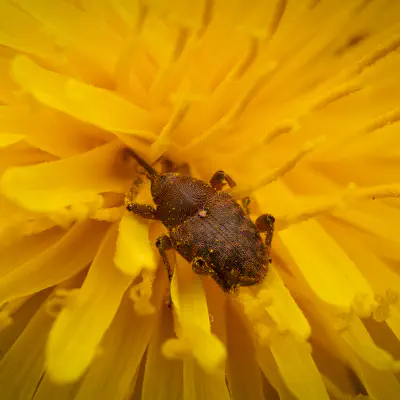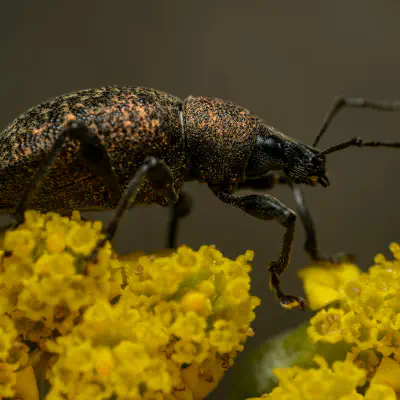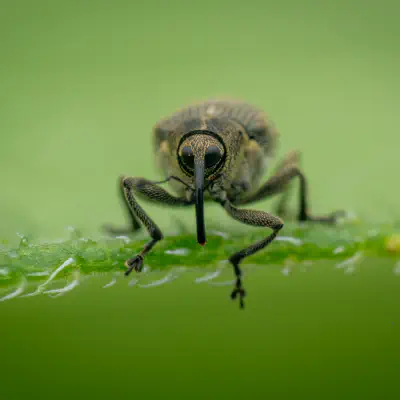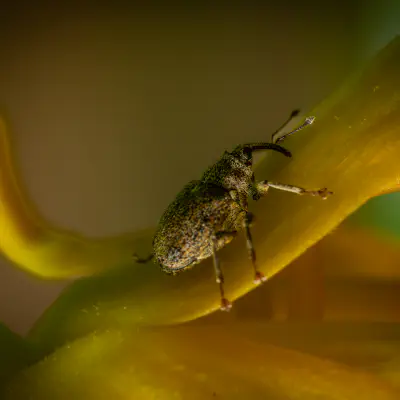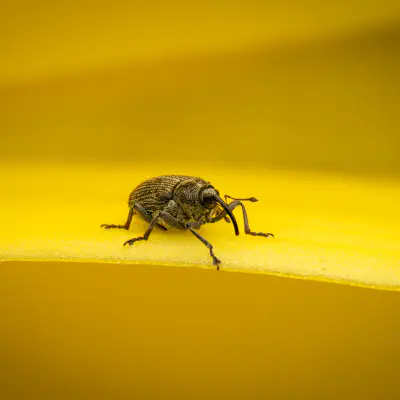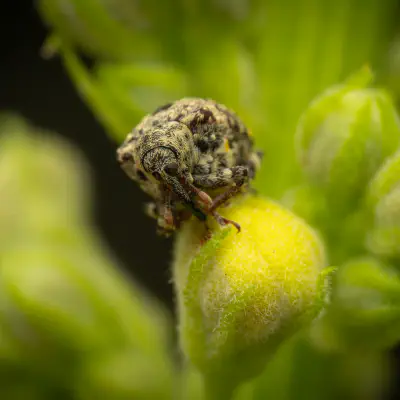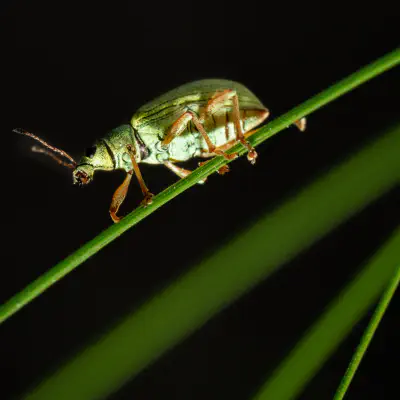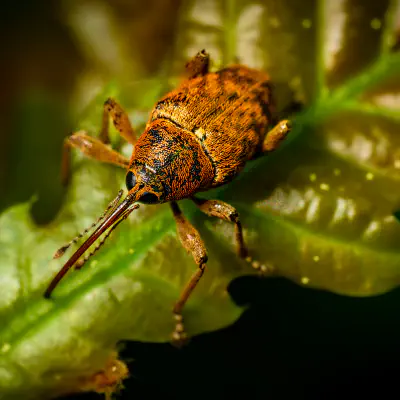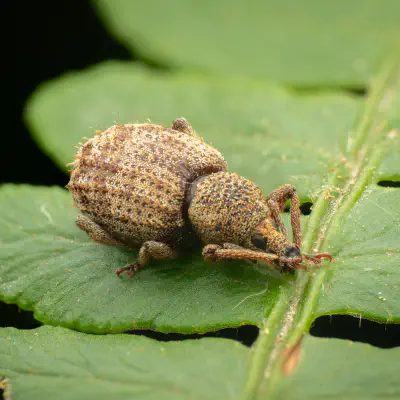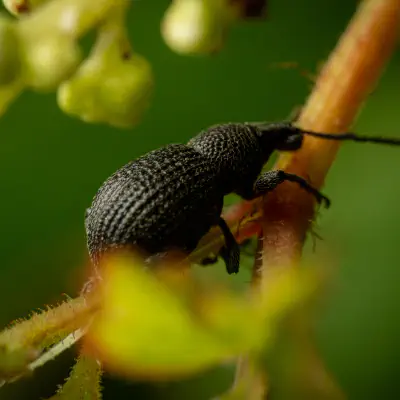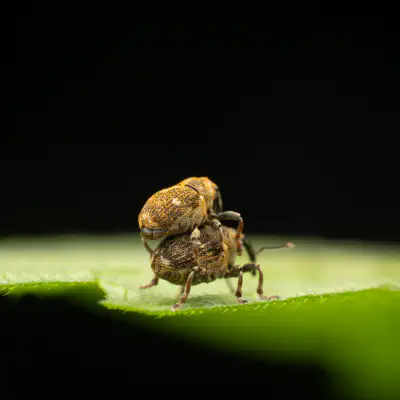True Weevils Lat. “Curculionidae“
The Curculionidae are the family of the “true” weevils (or “snout beetles”). They are one of the largest animal families, with 5,489 genera and 86,100 species described worldwide.
Hierarchy
Description
Adult Curculionidae can be recognised by the well-developed, downwards-curved snout (rostrum) possessed by many species, though the rostrum is sometimes short (e.g. Entiminae). They have elbowed antennae that end in clubs, and the first antennal segment often fits into a groove in the side of the rostrum. The body tends to be robust, convex, heavily sclerotised and covered in scales or bristles. Curculionidae range in size from 1–35 mm long, usually being 5–15 mm long. Most Curculionidae are sexually dimorphic with females (compared to males) having antennae positioned more basally and a longer, thinner rostrum. Larval Curculionidae are C-shaped and lightly sclerotised, with minute antennae, robust mandibles and no legs.
Most weevils feed on plants as larvae and adults, and they include important pests of cultivated plants that chew holes in fruits, nuts and other parts. The long rostrum possessed by most adult weevils is used by females to help lay eggs (oviposit) inside plant tissue. Some feed on rotten wood or bark (e.g. Cossoninae and Cryptorhynchinae), and some are wood-borers that feed on ambrosia fungi (Platypodinae and some Scolytinae). Although pesticide resistance hasn’t historically been an issue with these insects, recently a mutation was discovered in association with the voltage-gated sodium channel in the species Sitophilus zeamais, indicating there is a lot to learn about how these insects adapt to changing environments.
Behavior
When disturbed, adult curculionids often play dead by lying motionless on their backs. Many species of weevils are common household and garden pests, but don’t harm people, pets, or buildings. Their presence is more of a temporary nuisance, usually to plants and their fruits in their larval stage. In tropical areas they have larger effects, specifically several species in the genera Conotrachelus and Copturus.
Phylogeny and systematics
The phylogeny of the group is complex; with so many species, a spirited debate exists about the relationships between subfamilies and genera. A 1997 analysis attempted to construct a phylogeny based mainly on larval characteristics. Recent work on the phylogenetic relationships in weevils mentions the two subfamily groups Adelognatha (short-nosed weevils, subfamily Entiminae) and Phanerognatha (long-nosed weevils, subfamilies of Curculionidae other than Entiminae) for the species of Curculionidae. Almost two dozen subfamilies are recognized by some authors even when merging those that are certainly invalid. Others, however, recognize a lesser number – the only subfamilies that are almost universally considered valid are the Baridinae, Cossoninae, Curculioninae, Cyclominae, Entiminae, Molytinae, Platypodinae, and Scolytinae. The various proposed taxonomic schemes typically recognize as many additional subfamilies again, but little agreement is seen between authorities about which. In particular, the delimitation of the Molytinae has proven difficult. The timeline for current and extant weevil speciation and diversification is consistent with the radiation of gymnosperms during the Mesozoic period.
The subfamilies considered valid by at least some authors today:
Bagoinae (sometimes in Molytinae) Baridinae Brachycerinae (disputed; sometimes placed at family level) Ceutorhynchinae (sometimes in Baridinae) Conoderinae (sometimes in Baridinae) Cossoninae Cryptorhynchinae (sometimes in Curculioninae) Acalles Curculioninae – flower weevils, acorn and nut weevils
Cyclominae Dryophthorinae (sometimes placed at family level) Entiminae – broad-nosed weevils Hyperinae (sometimes in Molytinae) Lixinae (sometimes in Molytinae) Mesoptiliinae (sometimes in Molytinae) Molytinae Orobitidinae (sometimes in Baridinae) Platypodinae – typical ambrosia beetles, “higher” Curculionidaes Raymondionyminae (sometimes in Brachycerinae) Scolytinae – bark beetles Xiphaspidinae (sometimes in Baridinae)
See also
Black vine weevil Boll weevil Pecan weevil Wheat weevil Hylobius Orthorhinus cylindrirostris Premnotrypes Scolytoplatypus Pests and diseases of roses
External links
Media related to Curculionidae at Wikimedia Commons Data related to Curculionidae at Wikispecies
Ancestry Graph
Further Information
„True Weevils“ on wikipedia.org
„True Weevils“ on iNaturalist.org
Copyright

This article uses material from the Wikipedia article Curculionidae the free encyclopedia Wikipedia which is released under Creative Commons Attribution-ShareAlike 4.0 International License). On Wikipedia a list of authors is available.

Little beings in print
Order our calendars and books today!
Compiled with love. Printed sustainably. Experience our little beings even more vividly in print. All our publications are available for a small donation.


